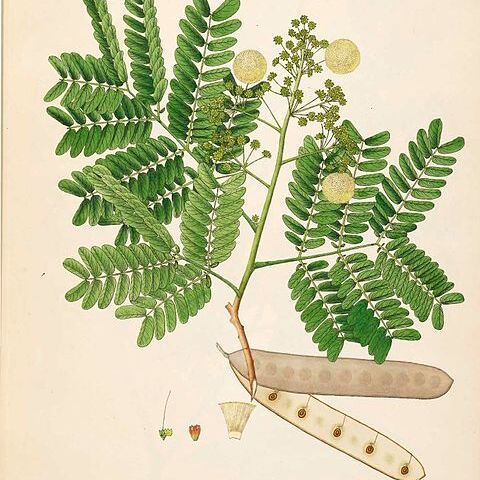Trees, evergreen, 5-15 m tall. Branchlets pubescent when young. Stipules filiform, ca. 2.5 mm, caducous; leaf glands 1-2 cm above base of petiole and rachis between first and second pinnae, elliptic; pinnae 2-4(-6) pairs; leaflets sessile, 6-14 pairs, oblong, 2-3 × 0.7-1.4 cm, papery, both surfaces sparsely appressed pubescent, main vein eccentric, close to upper margin, base obliquely truncate, apex obtuse, sometimes mucronate. Heads arranged in panicles, ferruginous pubescent. Flowers dimorphic, 10-15, sessile, yellowish, fragrant. Calyx cup-shaped, 1-1.5 mm, puberulent to tomentose; teeth shorter than 0.25 mm. Corolla funnel-shaped, 4.5-6.5 mm; lobes lanceolate, 2-2.5 mm. Staminal tube ca. as long as corolla tube. Ovary ferruginous tomentose; stipe ca. 1 mm. Legume oblong, compressed, 10-18 × 2-4 cm, densely pubescent when young, sparsely pubescent when mature. Seeds 6-12, ovate in outline, ca. 9 × 6 mm; pleurogram narrowly ovate. Fl. Apr-Jul, fr. Jun-Oct.
More
A tree. The bark is grey with patches. The leaves are alternate. The stalk of the leaf has a black gland near the base. The leaves are 10-20 cm long with 3-8 pairs of pinnae. These are 5-9 cm long and each have 8-20 pairs of leaflets. These leaflets are 1.7-2.5 cm long by 5-10 mm wide. The flower heads are solitary. The flowers are pale yellow. The fruit is a pod 10-30 cm long and 1.7-3.5 cm wide. These are reddish-brown. There are 8-12 seeds.
It is a tropical plant. It is best in well composted, moist, well-drained soil. It needs a protected, sunny position. It is sensitive to drought and frost. In southern China it grows in thin forests from sea level to 1,500 m above sea level.
More
Scattered in thin forests from sea level to 1,500 metres. Open areas, dry deciduous forest, secondary forest, fire damaged forest, hill mixed evergreen forest, hardwood forest, at elevations from 400-1,500 metres.


